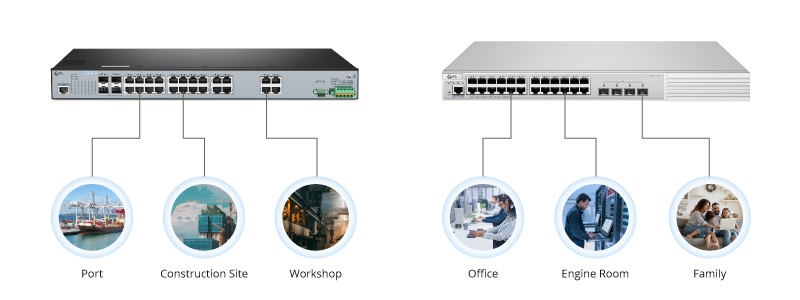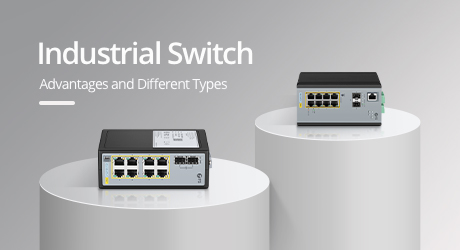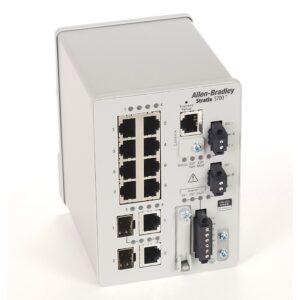Your Trustful Industrial Switch Supplier
Discover the power of advanced technology with Industrial Automation Products from Yingwangxin. As a leading automation products company, our product range includes drives, PLC modules, inverters, HMI’s, motors, control systems, power supply, circuit breaker and more, all designed to enhance operational efficiency. With products from leading brands like Siemens, Mitsubishi, Allen-Bradley,ABB and etc, we offer solutions that are reliable, high-quality, and tailored to your specific needs.
Showing 1–12 of 13 results
-
Allen-Bradley
1783-BMS06SA New Allen-Bradley AB Stratix 5700 6 Port Managed Switch
Read moreRated 0 out of 5 -
Allen-Bradley
1783-BMS06SGA New Allen-Bradley AB Stratix 5700 6 Port Managed Switch
Read moreRated 0 out of 5 -
Allen-Bradley
1783-BMS10CA New Allen-Bradley AB Stratix 5700 10 Port Managed Switch
Read moreRated 0 out of 5 -
Allen-Bradley
1783-BMS10CGA New Allen-Bradley AB Stratix 5700 10 Port Managed Switch
Read moreRated 0 out of 5 -
Allen-Bradley
1783-BMS10CGL New Allen-Bradley Stratix 5700 10 Port Managed Switch
Read moreRated 0 out of 5 -
Allen-Bradley
1783-BMS10CGN New Allen-Bradley AB Stratix 5700 10 Port Managed Switch
Read moreRated 0 out of 5 -
Allen-Bradley
1783-BMS10CGP New Allen-Bradley AB Stratix 5700 10 Port Managed Switch
Read moreRated 0 out of 5 -
Allen-Bradley
1783-BMS10CL New Allen-Bradley AB Stratix 5700 10 Port Managed Switch
Read moreRated 0 out of 5 -
Allen-Bradley
1783-BMS20CA New Allen-Bradley AB Stratix 5700 20 Port Managed Switch
Read moreRated 0 out of 5 -
Allen-Bradley
1783-BMS20CGL New Allen-Bradley AB Stratix 5700 20 Port Managed Switch
Read moreRated 0 out of 5 -
Allen-Bradley
1783-BMS20CGN New Allen-Bradley AB Stratix 5700 20 Port Managed Switch
Read moreRated 0 out of 5 -
Allen-Bradley
1783-BMS20CGP New Allen-Bradley AB Stratix 5700 20 Port Managed Switch
Read moreRated 0 out of 5
REQUEST A QUOTE FOR MORE DETAILS
What is a switch?

Consumer Switches vs. Industrial Switches

Consumer switches, often called home switches, are commonly found in offices and households. They are commonly used to connect devices on a home network. Such devices may include printers, smart home devices, gaming consoles, computers, and other everyday devices.
Industrial switches are used to connect industrial equipment, such as sensors, controllers, and other nodes. They are designed to be rugged and reliable so that they can withstand harsh conditions, such as humidity, extreme temperatures, and vibration, to name a few. They are built with a heavy-duty metal casing that prevents damage to internal components and electromagnetic interference. They are made with industrial grade components suitable for use in manufacturing, transportation, and automation.
If the switch is being used in a climate controlled office building, you can get by with a simple consumer rated switch. However, if you are planning to use the switch in an industrial environment, using a consumer switch can harm your operation. Attempting to use one can result in:
- Increased downtime
- Poor network performance
Safety hazards
Consumer switches are notorious for inadvertently ceasing operation when exposed to higher temperatures beyond the well circulated air of an office environment.
It is true that industrial switches cost more than consumer switches, but you get what you pay for. By using the correct switch, you can save money in the long run by reducing your maintenance costs and unexpected downtime.
How does an industrial switch work?

Industrial switches are responsible for ensuring that data being sent to a device is reliable, secure, and arrives intact. The process in which industrial switches transmit data between devices over a network can be broken down into three steps.
Step One: Receiving Packets
When a device sends data to an industrial switch, it becomes broken down into packets. The switch buffers them before they are sent out to their destination, indicated by the MAC address. When a switch receives a data packet, it reads the source address and decides which port the data will be sent through.
Step Two: Encapsulation
Before data packets are transmitted, they are encapsulated with more information, such as headers and trailers to ensure that data will reach the correct destination. This information contains the destination address and the source of the data. The data header can also contain information about the sent data and priority level. At times, an industrial switch may add tags to the data packet.
VLAN tags allow multiple LANs to share a physical network.
Quality of Service (QoS) tags give certain data types priority over others to ensure critical data is transmitted with minimal delay.
Once encapsulated, data is ready to be sent to its appropriate destination. When the data packet reaches its destination, the header and additional information are removed.
Step Three: Transmission
If the MAC address can be found in the switch’s MAC address table, it will send that packet to the device via the assigned port. If the MAC address is unrecognized, the switch will flood the packet to all ports besides the one from which the packet was received in an attempt to locate the receiving device. When located, the destination device will respond to the message, allowing the switch to learn the MAC address and map it to the correct port for the next time.
Industrial Switch Benefits
Higher Temperature Rating
The temperature rating of an industrial switch refers to the maximum temperature at which it can operate without sustaining damage or failure. Industrial switches are often placed in closed cabinets where there is minimal cooling airflow and the ambient temperature is high. A standard industrial switch can typically rated to withstand temperatures ranging from 32 to 140 degrees Fahrenheit (0-60 degrees Celsius), while higher temperature-rated switches can sustain temperatures up to 176 degrees Fahrenheit (80 degrees Celsius).
Extended Durability
The durability of industrial switches is simply unmatched compared to basic consumer switches. They feature robust housing that is designed to withstand even the most brutal environments. Housed in rugged metal closures, industrial switches can withstand moisture, vibration, dust, heavy impact, and even lightning. This is why they are often used in mines, railways, rapid transit, factories, and other stressful environments.
Cost-Effectiveness
Because they are built with the highest-quality industrial components, they are more reliable and have an extended lifespan. In fact, industrial switches have a service lifecycle of up to ten years. Though they cost more than standard consumer switches, their extended lifespans and increased reliability result in significant cost savings over time.
Improved Network Determinism
Network determinism describes the ability to ensure that data reaches its destination safely and consistently. When you use a low-quality switch or one that is not suitable for an industrial setting, you run the risk of experiencing the following problems: Dropped packets Network congestion And unpredictable latency Using a switch that cannot support network determinism can also lead to poor application performance, system failures, and a frustrating user experience. With the right switch, especially the ones listed later in the article, you need not worry about any of these issues.
Data Integrity
Industrial switches are responsible for maintaining the data integrity of a network by providing reliable communications infrastructure. Industrial switches only send data to the necessary port according to the MAC address. The switch learns each node's location and establishes a temporary connection with the device to transfer data.
Redundant Power Supply
To ensure continuous operation and minimal downtime, industrial switches may utilize redundant power supplies, which provide a backup power supply should there be a power failure. This ensures that the switch can continue to operate without missing a beat. To achieve this, industrial switches can be connected to two power sources. This can be two AC, or one AC and one DC power source.
Advanced Management Tools
Industrial switches also offer advanced management tools that make life easier for control engineers. Perhaps one of the most beloved of these is BSD file support, which allows administrators to save and restore configuration settings. This is incredibly useful for networks using multiple switches. BSD file support also grants the following benefits: Simplify switch configuration Reduce time required to update and configure network switches Minimize configuration errors. By providing an easy-to-edit, text-based format for switch configurations, BSD file support can enable the automation of configuration tasks while reducing the risk of human error.
Industrial Certification Required
To ensure that they are suitable for the often harsh industrial environment, industrial switches are required to meet certain standards and certifications. The following are a few certifications and standards that these switches have to meet. Ingress Protection Rating: the IP rating measures the degree of protection the device has from contaminants, such as dust, water, and other debris. Underwriters Laboratories Listing: UL testing evaluates the switch based on safety and performance criteria, such as fire resistance, stress and impact resistance, and electrical safety. CE Certification (Conformité Européene): this ensures that the switch meets European health, safety, and environmental standards. Federal Communication Commission Compliance: this ensures that the switch follows regulations pertaining to radio frequency emissions and interference set forth by the FCC. Restriction of Hazardous Substances (RoHS) Compliance: this ensures that the switch is not comprised of any hazardous substances, or that their concentration is below the maximum limits set forth by the European Union.
Industrial Protocol Support
The term Industrial Protocol Support refers to the ability of an industrial switch to communicate using specific industrial protocols. These industrial protocols are used to connect and control different nodes within the network. A few of these include PROFINET, EtherNet/IP, and Profibus. Certification ensures that the switch meets the specific requirements of the protocol and has been tested for interoperability with other devices in the network.
Better Security
Industrial switches help protect factories and infrastructure against bad actors and cyber attacks. Better security with industrial switches involves implementing a variety of security measures to protect against cyber threats. VLAN segmentation Port-based Network Access Control Redundancy and failover mechanisms IEC 62443 certification
Unmanaged / Managed Industrial Switches
A managed industrial switch enables comprehensive control over your Local Area Network (LAN), allowing for configuration, management, and monitoring of network settings. Designed for rugged environments, this type of switch facilitates intricate management of Ethernet LAN traffic within industrial settings. Meanwhile, an unmanaged industrial switch offers simplicity and convenience with its plug-and-play functionality, requiring no setup for immediate network integration.
Industrial PoE / Non-PoE Switches
PoE switch is a networking device with PoE passthrough that has multiple Ethernet ports to connect network segments. It not only transmits network data but also supplies power via an Ethernet network cable. Non-PoE switch, as the name suggests, there is no PoE in the switch to supply electrical power for end-users over Ethernet. PoE/non-PoE switches that feature an industrial design that can provide resistance to moisture, dust, dirt, oil, or other foreign substances that might otherwise damage the equipment are called industrial PoE switches or non-PoE switches. The high-capacity PoE budget of an industrial PoE switch can be leveraged to deploy and power nearby substation field equipment including IP surveillance cameras and valve controls. Note: An industrial PoE switch can also be divided into managed industrial PoE switch and unmanaged industrial PoE switch.
DIN-rail Switch / Rackmount Switch / Wall-mount Switch
Industrial Ethernet switches support different mounting types and can be installed exactly where you need them, whether on a standard DIN-rail (a widely used standard metal rail used to mount control equipment in industrial networking solutions), in the control cabinet, or outside the control cabinet. Frequently used industrial switches include DIN-rail, wall-mount, and rackmount models. These specially designed switches can provide flexible mounting options for easy installation, which is ideal for efficient use of cabinet space in harsh environments.
Diverse Types of Industrial Switches
Industrial switches come with a variety of functions and features. Based on these characteristics, switches can be categorized as either managed or unmanaged, with or without Power over Ethernet (PoE), and designed for DIN-rail or rackmount installation. The following breakdown elucidates these distinctions:

Conclusion
Nowadays, industrial switches are effective building blocks for corporate and manufacturing or industrial networks worldwide. Using highly durable housings and a compact footprint, industrial Ethernet switches are designed to fit in confined spaces and operate in harsh environments as we have explained in above contents. If you are looking for reliable network switches for industrial deployment, you can always trust Yingwangxin ltd.
How do I choose an industrial Ethernet switch?

The initial decision to make when selecting an industrial Ethernet switch is whether to go with a managed switch or an unmanaged switch. Unmanaged switches are simple, straightforward to operate, and generally more affordable. However, unmanaged switches do not provide monitoring, alert, or alarm functions. Moreover, they often do not allow administrators to control network traffic through protocols such as Quality of Service (QoS). Managed switches include all of these functionalities and more.
It is important to determine if you need Power over Ethernet (PoE). PoE switches can deliver power to and transfer data from external devices such as IP cameras, wireless hotspots, VoIP phones, and other PD devices. Industrial PoE switches have different power output capacities per port and varying total power budgets.
Port count and speed are also factors to consider. You will need enough ports to connect all devices, and those ports must be fast enough to handle your data requirements. Port speed options include fast Ethernet, gigabit Ethernet, and 10G, which require fiber ports or a small form-factors (SFP) pluggable transceiver.
Request A Free Quote
We'd like to work with you
Send us a message if you have any questions or request a quote. Our experts will give you a reply within 24 hours and help you select the right valve you want.
- +86 175 0301 5773
- +86 189 2656 9286
- info@yingwangxin.com














